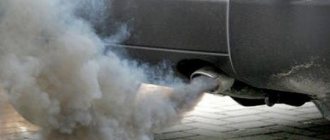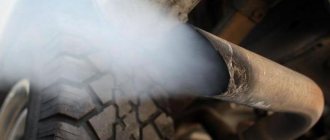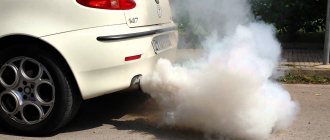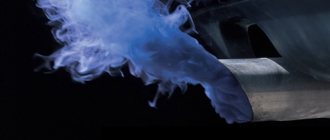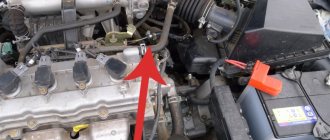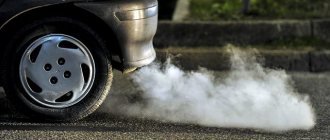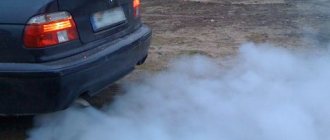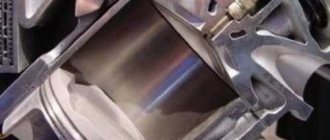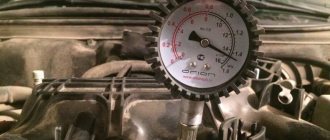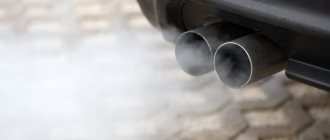Typically, when all vehicle systems are in good condition, exhaust gases from a warm engine are colorless. Therefore, the appearance of black smoke from the exhaust pipe may alert an attentive motorist. However, trouble does not come alone and often, along with the appearance of smoke, starting the engine becomes difficult, fuel consumption increases, the engine begins to work intermittently and traction is lost. Such symptoms will not leave even the most inattentive and lazy driver indifferent.
What does black smoke mean from the exhaust pipe of a gasoline engine?
Car muffler emissions poison the environment - this is a problem on a global scale. Manufacturers, caring about the environment, strive to purify exhaust to combine nitrogen with carbon dioxide and water vapor.
The ideal option is only possible if the power unit, ignition, fuel supply or cooling systems are in good working order. Black smoke from the exhaust pipe of a gasoline engine indicates a breakdown of the engine or auxiliary modules. Therefore, the appearance of a symptom requires inspection and repair of the vehicle’s chassis components.
Spare parts, maintenance
Products from the Dustershop77 range that may be of interest to you:
| Name | Manufacturer | Price | Availability | Add to cart |
| DC495 | Discount card (Dusterclubs.ru, Dustershop77.ru) | 700 / 500 rub. Discount: 500 rub. | >10 | |
| DC218 | Air deflector “Warm feet” for Duster, Logan, Sandero, Largus | 900 / 350 rub. Discount: 250 rub. | >10 | |
| DC654 | Frill with fastening without 3M tape (Duster/Terrano) (ArtForm) | ArtForm (Yuago) | 3000 / 2000 rub. Discount: 1600 rub. | >10 |
| PT014-RDU112901 | Trunk sill trim PTGroup | Pt GROUP | 1200 / 1000 rub. Discount: 900 rub. | >10 |
| 005-008502 | Trunk sill protection | Russian Artel | 1400 / 1100 rub. Discount: 1000 rub. | >10 |
| DG-006-GARD-RDSHCH | Front diffusers - aerodynamic flaps Renault Duster (set of 2 pieces) | Duster-Guard | 700 / 600 rub. Discount: 500 rub. | >10 |
| DC1024-V117 | Windshield and roof edge seal | Duster-Guard | 700 / 500 rub. Discount: 300 rub. | >10 |
| R12711 | Wind deflectors (window deflectors) COBRA/Autoplex | COBRA/Autoplex | 2000 / 1600 rub. Discount: 1500 rub. | >10 |
| NRD-009102 | Frill under the windshield (RA) | Russian Artel | 2500 / 2100 rub. Discount: 1800 rub. | 5 |
| RA0052 | Door sill trims (front+rear) RA | Russian Artel | 2500 / 2000 rub. Discount: 1700 rub. | 9 |
Why is there black smoke coming from the exhaust pipe?
In properly tuned internal combustion engine cylinders, the air-fuel mixture burns out completely. When black smoke comes out of the exhaust pipe of a gasoline engine, this means that soot has appeared in the emissions - dense particles of unburned hydrocarbons. Soot is clearly visible on freshly fallen snow and the walls of the exhaust tract.
At high speeds
The appearance of coal-dark smoke on a warm engine is associated with an over-enriched fuel mixture in the combustion chambers. The first to come under suspicion is the air filter (AF), which loses its capacity due to accumulated dirt.
Black smoke from the exhaust pipe on gasoline at high speeds also appears due to a faulty fuel pump. It would be useful to check the ignition system and oxygen sensor - lambda probe.
Intense black smoke
When starting the car
When the engine is warming up, especially in cold weather, small clouds from the exhaust tract should not cause alarm: the proportion of air and gasoline in the working mixture for the cylinders has not yet been restored. And the fuel does not have time to burn, settling into flakes of soot.
But if a short-term phenomenon does not disappear in motion, pay attention to the following elements and systems:
- valve stem seals;
- engine sensors;
- fuel quality;
- oil filter.
It is possible that the piston group parts are partially stuck.
When degassing
When you vigorously press the accelerator pedal, a sharp injection of fuel mixture occurs into the working chambers - unburned, and therefore thrown out onto the street.
Adjustments require:
- Faulty oxygen sensor.
- Fuel pump creating excessive pressure.
- Clogged with VF sediments.
On new engines, immediately after revoking the blackish mark disappears.
Repair
If you find a crack in the cylinder head, then we can only recommend replacing the head. However, prices... Therefore, many car enthusiasts do not disdain contract details. These are used parts from Europe.
Cracked cylinder heads can be repaired, but we will not recommend this technology, because during such repairs a hole is drilled that will fit into the crack, and then a copper rod is pressed into the hole. There will be no blow-by, but one of the cooling valves will be blocked halfway. Such a head will have a significantly reduced resource.
Causes of black smoke depending on engine type
Car engines run on gasoline (carburetor and injection designs) and diesel. The units differ in the way fuel is injected into the combustion chambers, therefore the causes of black smoke from the muffler are different.
Carburetor
The good old (and half-forgotten) carburetor is found on mopeds, motorcycles, walk-behind tractors, scooters, and Gazelles of early years of production. An important condition for the operation of a simple and reliable design with single injection is the correct stoichiometric composition. This is the ratio of fuel to air, normally 1 to 15.
But the balance can be upset due to a number of circumstances:
- debris got into the air jets;
- excess fuel appears in the float chamber;
- mechanical problems have arisen with the throttle valves;
- emulsion tubes fell out;
- the operation of the elements dispensing gasoline was disrupted.
A lean as well as a rich mixture produces poisonous black smoke from the exhaust pipe of a carburetor gasoline engine. In this case, the unit must be disassembled, washed, and repaired. To restore functionality, a simple set of plumbing tools is enough.
Black smoke at idle
Injector
In cars with a targeted supply of fuel to the cylinders (for example, Mercedes, Ford), the problem is fully present. There are many reasons for black smoke from the exhaust pipe of a fuel-injected gasoline engine. But diagnosis is complicated by the complexity of the mechanism.
Problems with injectors
Electromechanical devices are located in front of the intake valve. One of the elements of the fuel injector is the atomizer. When it wears out, fuel overflow occurs, resulting in thick black smoke pouring out of the muffler.
Faulty sensors
The injector is replete with sensors. Sensors control:
- air flow;
- engine temperature;
- crankshaft and throttle position;
- detonation and phases.
The operation of the controllers goes wrong for various reasons, then the elements transmit distorted information to the ECU. The block generates incorrect commands to the actuators: the motor begins to smoke.
Fuel pump
The gasoline pump (PG) in an injection power system is perhaps the most important component. However, the pump can create excessive pressure, although its regulator is considered quite reliable. The result of the violation will be soot emissions from the muffler.
Diesel
When a heavily loaded KamAZ smokes as it climbs the mountain, the picture surprises no one. But passenger cars, such as Volkswagen Passat, Hyundai Sonata, Kia Rio, and Niva Chevrolet, run on diesel fuel and also emit toxic combustion products. Emissions can tell a lot about the condition of a car's components.
Particulate filters
The cellular structure of diesel particulate filters traps solid particles of combustion products ranging in size from 10 nm to 1 micron. Filter elements in pairs are located behind the catalysts. Or they are built directly into the metal body of the exhaust gas neutralization device.
Particulate filters
The particulate filters contain differential pressure and temperature sensors that monitor the degree of contamination of the elements and transmit information to the engine ECU.
Clean filter elements allow only 0.1% of harmful compounds into the atmosphere. Particulate filters cannot be repaired, so if they become critically dirty, the consumables must be replaced.
High pressure pump
In the high pressure fuel pump (HPF), the speed sensor may fail or there will be a diesel fuel leak. The pressure in the pump should be 300 kg/cm2, which can be verified using the RB-4802 tester or another similar device. Water often gets into the plunger pairs of the device, then when the motor starts, the pump will jam.
A fuel injection pump malfunction is accompanied not only by a black tail at the rear of the car, but also by increased fuel consumption, engine overheating, and extraneous noise from the power plant.
Ignition timing
The air-fuel mixture in diesel engines is ignited by contact with air heated as a result of compression in the working chambers. Diesel fuel is supplied to the cylinders at a precisely calculated moment at the end of the compression stroke.
If the ignition angle is set incorrectly, fuel injection will not occur in a timely manner. A dark curtain that envelops road users will warn about inefficient combustion of diesel fuel.
Turbocharged engines
Aggregate air charging, which increases engine power with constant cylinder volumes, contributes to the occurrence of coal-colored smoke. The process is also accompanied by a characteristic whistle.
Look for and remove blockages in the air ducts, examine the intake tract and exhaust manifold: a leak may be found here.
Exhaust tract
Roar, metallic knocking, rattling from under the bottom of the car scream about breakdowns in the exhaust tract of the diesel internal combustion engine.
Collector defects are divided into three groups:
- Mechanical, obtained when hitting obstacles or meeting curbs. Cracks appear on deformed pipes, and the fracture sites burn out.
- Corrosive, appearing from moisture, reagents, condensate. The metal parts of the exhaust tract rust and deteriorate.
- Operational, caused by natural aging processes.
When the collector has served its purpose, it will smoke when starting, accelerating and decelerating the car: solid carbon particles will not encounter obstacles in their movement onto the street.
Good old carburetor
What does dark exhaust coming from a car mean? With carburetor engines everything is simple and clear. Most owners of cars with such an engine encountered one problem when it flooded, and it began not only to sneeze, but also to trip. All this was accompanied by clouds of smoke from a black muffler.
Responsibility usually lies with one of the following:
- carburetor needle valve;
- ignition;
- piston rings, valves.
Sometimes the needle valve begins to stick or allows a lot of fuel to pass through, which actually leads to a richer mixture. The result is its incomplete combustion. And if you pour low-quality gasoline into the tank, this threatens to clog the jets.
Another reason lies in the spark plugs or incorrect ignition timing. The result is identical - the fuel does not burn completely, and black smoke begins to pour out of the chimney.
Finally, the problem is caused by worn piston rings, as well as worn out valves. But in order to eliminate it, you shouldn’t act on your own, relying on your own strength - you need the help of qualified craftsmen.
What to do and how to eliminate black smoke from the exhaust pipe
A novice driver who notices black smoke from the exhaust pipe of a carburetor or injection gasoline engine should contact a car repair shop.
You can do the following yourself:
- refuel at another gas station if you doubt the quality of the fuel;
- replace fuel and air filters;
- clean the injector electronics with gasoline with special detergent additives;
- check the operation of the injectors and carburetor;
- observe the pressure in the combustion chambers, compare the data obtained with the nominal value;
- Don’t forget about diesel particulate filters: change the elements every 15-30 thousand km on the speedometer.
Watch your own driving style: extreme style with sharp starts and frequent braking at high speeds does not allow fuel to burn out effectively.
Making a diagnosis based on exhaust colors
Diesel engines, as well as gasoline engines, can have exhausts of various colors. More often it is white, bluish, gray and black smoke.
Let's start with white. Often white is the name given to smoke with a bluish tint. This happens when the turbine is destroyed and the lubricant gets directly into the intake tract. In such a situation, bluish smoke pours out of the chimney. But an inexperienced car enthusiast will easily mistake it for white smoke. And if you smell it, then it’s immediately clear and understandable what the reason for its appearance is.
Many people have burned vegetable oil or butter in a frying pan at least once in the kitchen. The smell is about the same. This smoke can also be confused with steam, which is more often observed in the winter months from the exhaust of not only diesel cars. It's all because of the water that appears as a result of combustion.
Later, after the engine has warmed up, the steam will not be noticeable, although it will not go away. This can be easily checked. You just need to place your palms near the exhaust. The palm will be slightly damp. This steam causes significant inconvenience when tuning the engine, especially in winter. For high-quality settings, you have to warm up the unit for a long time. And in cold weather the adjustment may not be possible at all.
